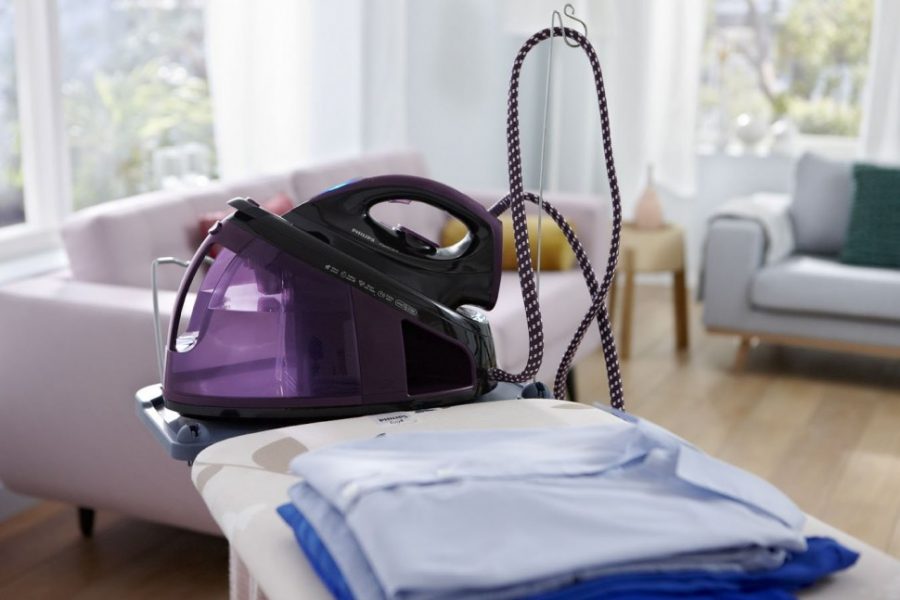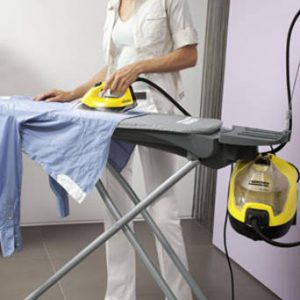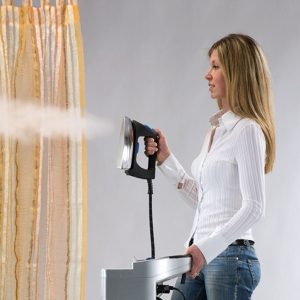A steam generator is popular in everyday life due to the ability to tidy outerwear, suits, curtains in a matter of minutes, not to mention everyday things. This device moisturizes the fabric much more efficiently than classic irons, reducing the time spent on ironing and leaving it for a more pleasant pastime.

Content
What is an iron with a steam generator?
An iron with a steam generator differs from the classic model by the presence of a boiler in which water is poured for steaming. Heated to a boiling point, it is supplied in the form of steam through a hose (hydraulic hose) and exits through the openings of the sole under pressure.

Compared to budget irons, steam generators moisturize tissue 3–7 times more intensively. Steam under pressure exits non-stop, penetrating through 3-4 layers of tissue and softening the fibers. Under the influence of high temperature from a heated sole, the fabric quickly straightens, folds are smoothed out.
The advantages of the device over a conventional iron:
- The steam station reduces the time needed to iron trousers, jackets, shirts and other things by a third.
- A powerful steam jet cleans and disinfects clothes.
- The device allows you to steam things that cannot be ironed with an ordinary iron: fur coats, sheepskin coats, dresses with a lot of frills.
- Steam escaping under pressure removes odors from clothing.
Using a steam generator is easy, it is enough to follow a number of simple rules.
How to use a steam generator
Each iron has nuances that must be considered when using. However, there are a few general guidelines that work with any model.
The process of working with a steam generator includes 4 stages:
- Filling with water.
- Heating / preparation for work.
- Ironing.
- Shutdown.
Let us consider in more detail the features of each stage of work.
Water filling
There are two types of boiler in steam generators: removable and non-removable. The removable tank can be disconnected from the base and filled with water in the bathroom. Fixed will have to be filled in place through a funnel or using a suitable container. It is strictly forbidden to place the device under the water tap for filling.
Pour water into the steam generator in the following sequence:
- Open the hole for filling;
- Pour water to the specified level of "MAX";
- Close the filler hole;
- Replace the removable tank.
It is forbidden to pour water into the garment steamer with the addition of starch, perfumes, vinegar and other chemical liquids.
Heating and preparation for work
After filling the tank, you can proceed directly to the start of work. To do this, you need:
- Remove the fixing elements that hold the iron on the base (if any);
- Connect the device to the network;
- Unwind the hydraulic hose and cord, connect the device to a grounded outlet;
- Press the power button.
From the moment the device is connected to the network, water heating will begin. The process may take 2-8 minutes depending on the model. As a rule, the corresponding indicator on the control panel or the audible alarm sounds when the iron is ready for operation.
After warming up the steam generator, you can start ironing and steaming.
Ironing
First of all, you need to set the desired mode depending on the type of fabric. Standard programs: synthetics, wool, cotton. In many models, there is an “Eco” mode, which allows you to save energy (reduces water supply and electricity consumption).A number of premium irons use technologies that allow ironing all types of fabrics in one mode (Optimal Temp, i-Temp).
The steam supply intensity is regulated depending on the selected mode - at low temperatures its quantity decreases, at high - it increases. On the control panel of some steam generators there is a regulator with which you can change the amount of steam supplied. However, if the sole is heated to a minimum and the steam is set to maximum, condensation may form.
In horizontal position
Using the iron with the steam generator in a horizontal position should be the same as using a conventional iron. Smooth fabrics by pressing the lever located under the handle. Steam is supplied continuously in a large volume. To get the best result, you can walk around things with an iron without steam (to dry them).

If the breaks between work were several minutes, during which the iron was at rest, condensation may accumulate in the hose. You can remove it by pressing the steam supply button several times.
Vertical steam
To steam clothes in an upright position, it is necessary to place them on a hanger. With one hand they extend the sleeves, lapels, back, with the other they lead the iron from top to bottom. Cuffs and collars can be ironed separately, on the board, can be upright, putting a heat-resistant substrate for stiffness.

Delicate things, clothes with sequins are processed in a gentle manner. If the fabric is thin, the iron is driven a few centimeters from the surface. When processing cotton and linen, the sole is allowed to come in contact with things.
The trousers fold the trouser leg to the trouser leg, hang it with the belt down and straighten it by running it along, from top to bottom.
Curtains are ironed with a steam generator until they are dry. First, they hang the fabric on the curtains, pull it in the center, and then pass the ironing. Then the bottom of the curtains is straightened and the canvas is steamed from the middle to the end.
After completion of work, the steamer should be put back to the base.
Shutdown
After completion of work, the water remaining in the tank must be emptied. To do this, disconnect the appliance from the mains, wait until it cools down and empty the boiler.
The cord and network cable are unwound and put into the storage compartment. The iron is placed on the platform and fixed with a lock.
Topping up water during operation
The possibility of topping up during operation is not provided in all steam generators and depends on the model. Two filling options are possible:
- Disconnect the device from the network and fill in water according to the standard scheme;
- In models with a screw-in valve, the steam generator is disconnected from the network and the boiler cover is opened a half-turn, releasing residual steam;
- When the appliance has completely cooled, the cap is completely unscrewed, the tank is filled with water and the iron is restarted.
Often there are models with a screw valve. In such devices, steam is under pressure and can burn if water is poured into a heated appliance.
What water to pour into the steam generator
Modern appliances are designed to use tap water. If the liquid is of poor quality, with a high content of impurities, manufacturers are advised to replace it with demineralized or distilled. It is allowed to use a mixture of tap water and distillate in a ratio of 50/50.
It is not recommended to pour settled, boiled, thawed or well wells. The use of special perfumed water for irons is allowed. However, due to the high flow rate of the liquid, its use may not be economically feasible.

How to care for the device
To extend the service life, steam generators for ironing clothes and clothes must be regularly descaled. The procedure consists of two stages:
- Descaling from the iron.
- Steam generator tank cleaning.
To properly descale the iron, fill the boiler with water and warm up the appliance to the maximum. If it is provided for by the model, turn on the “Cleaning” mode, if not, take the device in your hands and, continuously pressing the steam supply lever, empty the tank above the sink.
To descale the tank, disconnect the appliance from the mains and let it cool completely (this will take about two hours). The removable boiler is filled with water (approximately 300 ml), it is shaken well, then empty over the sink. The fixed tank is cleaned in the same way, only the base is not shaken, but gently turned over the sink 3-4 times.
Acid solutions, vinegar, descaling agents are not recommended for manufacturers.
Most models are equipped with a warning system that reminds of the need for cleaning. If there is no such system, descaling is recommended after every 10th use.